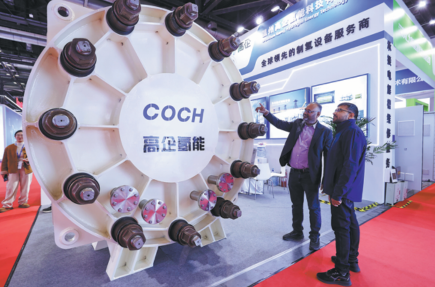
Foreign delegates check out hydrogen production equipment during a power expo in Beijing in March.
China emerged as a global leader in hydrogen energy production in 2024, with diverse investments highlighting industry dynamism and propelling the nation toward sustainable energy solutions, said officials and experts.
According to the latest data from the National Energy Administration, over 560 hydrogen energy-specific policies had been introduced nationwide by the end of 2024.Twenty-two provincial-level administrative regions have incorporated hydrogen energy development into their government work reports, advancing the industry's development based on local conditions.
By end-2024, production and consumption of China's hydrogen gas each exceeded 36.5 million metric tons, ranking first globally. By the same period, the cumulative capacity of projects that produced hydrogen out of renewable energy sources worldwide exceeded 250,000 tons per year, with China accounting for over 50 percent, gradually emerging as a leading nation in the sector, said the NEA.
Officials and experts noted that investments in hydrogen energy are diversifying from a primary focus on fuel cells to encompass a broader spectrum. This expansion ranges from upstream raw material research and development, midstream core component manufacturing, to downstream innovative application scenarios, indicating promising future prospects.
Xu Jilin, deputy director of energy conservation and technology equipment at the NEA, highlighted that China's northern regions boast a solid foundation in the development of traditional industries and abundant energy resources, laying a strong groundwork for the implementation and promotion of hydrogen energy projects.
In 2024, national hydrogen gas production exceeded 36.5 million tons, with northern regions accounting for over 50 percent, and Inner Mongolia autonomous region, Shanxi and Shaanxi provinces, Ningxia Hui autonomous region, among others, ranking prominently in hydrogen gas production.
Xu said that by the end of 2024, over 600 renewable energy-driven electrolysis of water for hydrogen production projects had been planned and constructed nationwide, with more than 150 projects either completed or in progress. Completed projects boast a total production capacity of approximately 125,000 tons per year. These projects are mainly concentrated in the Northwest and North China regions, collectively representing nearly 90 percent of the completed production capacity nationwide.
Xu noted that the demonstrative application of fuel cell vehicles is steadily progressing, with over 540 hydrogen refueling stations established across the nation and around 24,000 fuel cell vehicles being promoted.
"Furthermore, new technologies, application scenarios and business models such as electrolysis of seawater for hydrogen, liquid hydrogen plants, and cross-border trade are rapidly being explored in relevant regions, supporting the integrated development of the hydrogen energy industry," Xu said.
Alex Zhu, APAC industrials and energy industry group co-leader at accounting firm EY, said that at present, China's power system is transitioning into a phase dominated by green electricity, with efforts to stabilize traditional energy supplies and advance clean technology breakthroughs running concurrently.
"China took the lead in global hydrogen production, with its industrial chain capacity showing continuous improvement, setting a robust foundation for enhancing the quality and speed of the hydrogen energy development during the 15th Five-Year Plan period (2026-30)," Zhu said.
"The government is actively engaging private enterprises in the trillion-yuan ($138.8 billion) energy storage and distributed photovoltaic markets. Recent data indicate a two-pronged strategy of securing stable supply and pricing for traditional energy while establishing clean energy as a dominant player in the sector, marking a shift from simply expanding clean energy to enhancing its overall quality," he said.
"Looking ahead, more breakthroughs are expected in frontier technologies like hydrogen energy and carbon capture, utilization, and storage. Improvements are also expected in grid peak load shaving capabilities of the energy storage sector, among others."
liuyukun@chinadaily.com.cn

